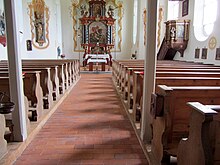St. Georg (Gwigg)
St. George is a chapel where the community Bergatreute ( Ravensburg district ) in Upper Swabia belonging hamlet Gwigg.
Description of the place and the chapel
Gwigg can be traced back to the word Gewicke or Wicken . Sweet peas are plants that seem to twist in an uncontrolled manner. In Gwigg in the humpbacked Upper Swabian landscape, the five streets coming from Ankenreute, Dinnenried, Stocken, Abetsweiler and Gambach meet at the Gwigger Chapel. The chapel is also a station on the Upper Swabian Way of St. James .
As early as 1353, the first documentary mention of a St. Georg chapel in Gwigg took place. In 1362 the Rot an der Rot monastery acquired the building along with ecclesiastical rights. State sovereignty and jurisdiction of Gwigg remained with the Landvogtei Oberschwaben until 1810 . Therefore, only the abbot's staff can be seen in the abbot's coat of arms on the western outer nave wall.
The current chapel dates from 1718. It was built by Abbot Hermann Vogler. Vogler was previously a pastor in Haisterkirch , a place that belonged to Rot an der Rot at the time. Walled into the foundation stone on the south side of the chapel, it reads : Soli deo honor et gloria 17 HAR 18 , where HAR stands for Hermann Abt in red. The patronage of St. George could point to a connection to the nearby Volkertshauser hamlet chapel , which also has a knight saint , Mauritius , as patron. It was not until 1763 that pastoral care was provided by the parish vicariate of the Norbertines in Molpertshaus.
The inventory of the year 1707 shows that the monastery had a single farm in Gwigg in addition to the church rights. Another two farms belonged to the women's monastery of the Cistercians in Baindt, the Waldsee hospital had two farms, as well as the Augustinian monastery St. Peter zu Waldsee one farm and the Upper Swabian bailiff had two farms. In 1755 the church was consecrated by the auxiliary bishop Karl Josef Fugger on behalf of the prince-bishop of Constance. According to existing building bills, the chapel cost 2,000 guilders. The value of a farm at that time was 1000 guilders.
Interior
The altarpiece shows a scene from the life of St. George. On the altar pedestal below is a representation of St. Norbert. The altar table is St. Reserved for the family, above the coat of arms of Abbot Hermann Vogler, in the essay Antonius of Padua, as a secondary patron of the church, flanked by two angels. At the top is a depiction of the Sacred Heart. The assistant figures in front of the altar are St. Konrad and St. Norbert, both works from the nearby Waldseer Zürn workshop.
On the wall of the nave there is a sculpture of St. Georg as a dragon slayer can be placed on the convertible altar, which was no longer used in 2011. A figure of Christ in the dungeon and the richly decorated pulpit complete the nave. The fresco in the choir is painted by Jakob Kuen from Weißenhorn and deals with the theme of St. Trinity. The main fresco of the nave, also by Kuen, is about a Premonstratensian saint and shows Hermann Joseph with the baby Jesus.
There is a belfry with a bell in the roof turret of the chapel.
literature
- Manfred Thierer / Ursula Rückgauer: Places of Silence. The chapels in the Ravensburg district . Ed .: District Office Ravensburg. Kunstverlag Fink, Lindenberg 2010, ISBN 978-3-89870-547-9 , p. 392 .
- Paul Sägmüller, Bergatreute: Chapel of St. Georg zu Gwigg - history and church guide through a baroque gem in Upper Swabia . Ed .: Förderverein St.-Georgs-Kapelle Gwigg eV Chairman Herbert Merk. Verlag und Offsetdruck Eppe GmbH, Aulendorf / Bergatreute, Gwigg 2006, p. 19 .
Web links
Coordinates: 47 ° 52 '8.1 " N , 9 ° 44' 7.8" E

